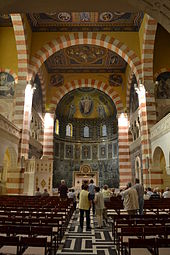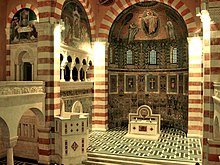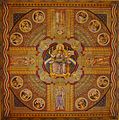Ascension Church (Jerusalem)
The Assumption Church ( Hebrew כנסיית העלייה, English Ascension Church , mostly simply Augusta Victoria ) is a sacred building completed in 1914 on the Mount of Olives in Jerusalem . It was established there in 1899 by the Empress Auguste Victoria Foundation on the Mount of Olives ( Mount of Olives Foundation ). In 1907 the foundation stone for a malaria hospital was laid and in 1910 the church was consecrated.
The church stands on one of the highest points in Jerusalem, 850 meters above sea level and almost 1,300 meters above the Dead Sea . The church is built in the Wilhelmine-Neo-Byzantine style . The entire west facade was surrounded by a massive porch to protect it from strong winds and rain. In the years 1988–1991, the works of art were restored to their original condition after the static restoration and the removal of the earthquake damage.
history
During Emperor Wilhelm II's visit to Palestine in the autumn of 1898 with his wife Auguste Victoria, the German Emperor asked the German-speaking Protestant communities in Jerusalem , Jaffa , Bethlehem and Haifa to have a rest home on the Mount of Olives - especially for people with malaria Building hospice for Christian pilgrims.
After a long search for a suitable building site, a first 81,000 square meter plot of land was acquired in November 1903, and further adjacent land in the following two years. In the summer of 1906, the Berlin architect Carl Gause and his friend and colleague Robert Leibnitz were commissioned with the construction. On Easter Sunday, March 31, 1907, the foundation stone was laid in the presence of the two architects. The inauguration of the hospice with the Church of the Assumption followed on April 9, 1910. The construction work was not completed until four years later.
At the beginning of the First World War (1914) the Ölbergstiftung served as the headquarters of the German-Turkish General Staff. The building complex was confiscated by the British in 1917. For the next ten years the British High Commissioner and his officials ruled the Mandate area from here.
The Jericho earthquake damaged the buildings in 1927. The tower had to be shortened by 10 meters. The International Mission Conference (a forerunner of the World Council of Churches) met in 1928 on the premises of the Mount of Olives Foundation. In 1937 the Diakoniewerk Kaiserswerth began to transform the hospice into a hospital. After the outbreak of World War II , the building was confiscated again in 1939 and used as a military hospital for the Arab Legion .
In 1948 the land and buildings were transferred to the Lutheran World Federation (LWF). After the war for Israel's independence , the International Committee of the Red Cross (ICRC) opened a hospital for Palestinian refugees in 1949. In 1950, the LWF and the United Nations Relief and Works Agency took over management of the hospital.
The hospital was rebuilt in 1966 and specialized in cancer, ear, nose and throat ailments. The Imperial Hall , inaugurated in April 1910, was restored with German public funds and private donations and was shown to the public in April 2010. In the future it should be available to all inhabitants of the Holy Land for cultural events. With Joachim Gauck , a German head of state visited the Ascension Church for the first time in 2012.
Artistic arrangement
The highlights of the rich artistic design are the paintings on the flat ceilings and - as precious works - the mosaics of the apse and the lunettes of the choir and the galleries.
The ceiling paintings were made in 1910/11 by the painter Schmidt from Haldersleben, who lives in Jerusalem, based on designs by Otto Vittali the Elder . J. executed in the lime-casein technique. The model was the wooden ceiling of St. Michael in Hildesheim . The paintings are divided into five fields by the yokes of the building. The cross of the church floor plan is followed by a painted cross in the fields of the ceiling painting, which runs through all five fields.
The painting of the crossing shows Jesus enthroned as a pantocrator , surrounded by four medallions with the symbols of the evangelists, four archangels and twelve tondi with the twelve apostles as chest pieces.
In the ceiling paintings above the organ gallery, both founders Auguste Viktoria and Wilhelm II are enthroned with the model of the church, surrounded by the rulers of the Crusader King Konrad III. , Emperor Barbarossa , Emperor Friedrich II. , Richard the Lionheart , Louis VII of France , Philip II August . Four other crusader kings, Gottfried von Bouillon , Balduin I and II and Fulko V. flank this scene.
The mosaic of the risen Christ in the apse was designed by Hermann Schaper from Hanover . It was originally produced for the Erlöserkirche in Gerolstein in the Eifel , but it was installed here after a decision by Empress Auguste Viktoria. An identical one was then produced again for Gerolstein and is in the church there. The Berlin mosaic company Puhl & Wagner was responsible for the execution .
The Passion cycle of four mosaic lunette pictures was also executed by Puhl & Wagner after 1910 according to the design by Ernst Christian Pfannschmidt . Pfannschmidt had designed a life of Jesus cycle for the Kaiser Wilhelm Memorial Church as early as 1903–1907 , but it has now been destroyed. The city of Jerusalem appears as the background for the crucifixion scene in the western lunette of the choir room .
The stone carvings deserve special interest because of their wealth of shapes - no motif is repeated - and their successful elaboration. They were carried out by local stone masons. Together with the floor, with its Byzantine pattern that can also be found in other parts of the city, the result is a rounded, harmonious overall impression, which is emphasized by the light that falls in warm colors through the gold glass and coat of arms windows.
organ
The pneumatic organ was built in 1910 by the organ builder Wilhelm Sauer in Frankfurt / Oder. It has been preserved in its original condition and is unique in this region.
The prospectus was designed based on the organ of the Erlöserkirche in Bad Homburg. The cone shop instrument is largely original. It has 24 stops on two manuals and a pedal . The playing and stop actions are pneumatic.
|
|
|
||||||||||||||||||||||||||||||||||||||||||||||||||||||||||||
- Coupling : II / I, I / P, II / P
Tower and bells
The Church of the Assumption stands on one of the highest points in Jerusalem, the northern tip of the Mount of Olives, 850 meters above sea level and almost 1300 meters above the Dead Sea, which is below sea level . Its tower with a height of 65 meters, which is open to the public for ascent, offers a good view of the city and the surrounding area.
The bells in the tower in the striking tones g 0 ( master's bell , 6,120 kg), h 0 , d 1 and e 1 were cast in 1910 in the Schilling bell foundry in Apolda . The names and dates engraved on the "Herrenmeister" bell, Gregor the Great (598), Gerhard Sasso (1098), Raymond du Puy (1120), Wilhelm II (1898) and Eitel Friedrich von Prussia (1907 and 1910) represent persons and Events in a context that Hohenzoller's view of history wanted to see at the time.
The Ascension Church today (as of June 2010)
Evangelical pilgrimage and meeting center
The Evangelical Center on the Mount of Olives works with the German-speaking Evangelical Church of Jerusalem ( Church of the Redeemer ). In addition to devotions for groups of pilgrims and tourists, public lectures, seminars and concerts are offered.
Cafe Auguste Victoria
Opposite the church is the Auguste Victoria café. On sunny and warm days, visitors can find coolness on the café terrace in the shade of the trees. On cold days there are cozy places in the sun. It serves as a central meeting point for various charitable and social aid organizations and also offers pilgrims, volunteers and everyone else a quiet place. The Café Auguste Victoria is run exclusively by volunteers. Also very popular is the “after-work” on Wednesdays with a menu prepared by volunteers.
hospital
see Auguste Viktoria Hospital .
literature
- Jürgen Krüger: Rome and Jerusalem. Church building ideas of the Hohenzollern in the 19th century , Akademie Verlag, Berlin 1995 ISBN 3-05-002427-5 , pp. 97-108.
- Jürgen Krüger: The Ascension Church on the Mount of Olives in Jerusalem , Langewiesche publishing house , Königstein i. Ts. 2010 (The Blue Books), ISBN 978-3-7845-0720-0 .
- Margarete Schilling : Bells for the Mount of Olives in Jerusalem 1910. Illustrated book, Apolda 2008 (without ISBN)
- Michael Trensky (Ed.): Evangelical Church of the Ascension and Hospice of the Empress Auguste Victoria Foundation on the Mount of Olives in Jerusalem. Hanover 1990.
Web links
- Empress Auguste Viktoria Foundation in Jerusalem
- The "Holy City" in 19th century German monumental painting (PDF file; 361 kB)
- German bells over Jerusalem - the chimes of the Ascension Church
Individual evidence
- ↑ Cf. The Auguste-Victoria-Himmelfahrtskirche from its construction until today , in: The Auguste-Victoria-Himmelfahrtskirche on the Mount of Olives in Jerusalem and its repair and restoration 1988 to 1993 , ISSN 1434-1166, pp. 11-17, here p 12.
- ↑ http://www.unserekirche.de/gesellschaft/weltblick/gauck-beendet-nahostreise-mit-kirchenbesuch_8635.html
- ↑ Information on the organ of the Ascension Church
- ↑ Margarete Schilling: Art, ore and sound. The works of the Ulrich / Schilling bell foundry family from the 17th century to the present day . Henschel, Berlin 1992, pp. 94, 223.
- ↑ Recording of the partial bell without a big bell
Coordinates: 31 ° 47 '12 " N , 35 ° 14' 57" E







